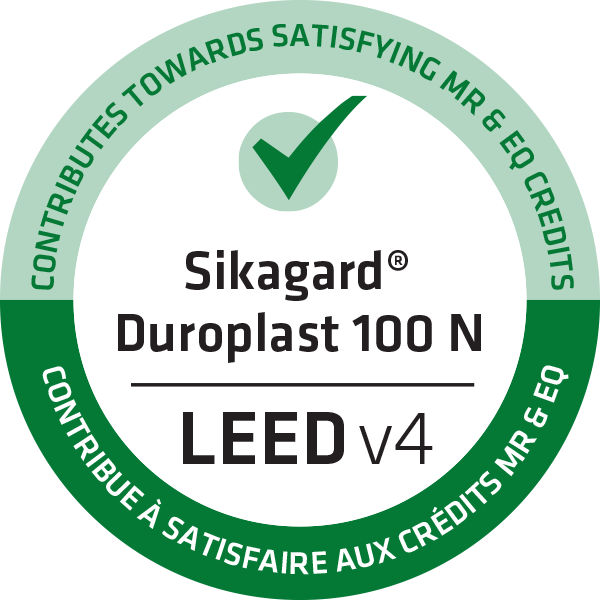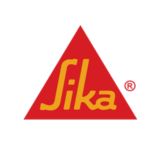
Sikagard® Duroplast-100 N
Sikagard® Duroplast-100 N is a two-part, high solids, low odour, low VOC, finely textured, glossy, pigmented epoxy wall coating. It produces a durable, easy to clean ceramic-like finish on interior surfaces. Can be applied over properly prepared and primed concrete, concrete masonry, common steel, or gypsum board substrates. It is also used as binder for multi-layered, glass fabric-reinforced wall lining systems that improve the durability of gypsum board against impact. Sikagard® Duroplast-100 N contains an antimicrobial additive that inhibits the growth of bacteria, molds, mildew and fungi for the lifetime of the coating.
- Durable seamless surface that is easily cleaned and maintained.
- Waterproof, suitable for in-service areas exposed to high humidity.
- Aesthetic, fine textured, glossy finish.
- Good chemical and abrasion resistance.
- High solids, low VOC, neutral odour.
- Fast recoat cure properties are ideal for shutdown or fast turnaround projects.
- Excellent opacity and colour hiding capability.
- Can be reinforced with fibreglass fabric.
- Contains a permanent antimicrobial additive.

Usage
- Hospitals and medical research facilities.
- Pharmaceutical laboratories and production areas.
- Veterinarian and animal holding areas.
- Educational and recreational premises.
- Commercial kitchens and service corridors.
- Food and beverage processing areas.
- Packaging and storage areas.
- Rest rooms, locker rooms and showers.
Advantages
- Durable seamless surface that is easily cleaned and maintained.
- Waterproof, suitable for in-service areas exposed to high humidity.
- Aesthetic, fine textured, glossy finish.
- Good chemical and abrasion resistance.
- High solids, low VOC, neutral odour.
- Fast recoat cure properties are ideal for shutdown or fast turnaround projects.
- Excellent opacity and colour hiding capability.
- Can be reinforced with fibreglass fabric.
- Contains a permanent antimicrobial additive.
Packaging
3.78 L (1 US gal.) and 18.9 L (5 US gal.) units
Colour
RAL 9016 Traffic White
Special colours available on request.
Product Details
ENVIRONMENTAL INFORMATION
Potential of contribution towards LEED®v4 credits. Contact Sika Canada.
APPROVALS / CERTIFICATES
Meets the requirements of CFIA and USDA for use in food plants.
Shelf Life
1 year in original, unopened packaging under proper storage conditions.
Storage Conditions
Store dry at temperatures between 5 °C to 32 °C (41 °F to 89 °F).
Precondition material for at least 24 hours between 18 °C to 30 °C (65 °F to 86 °F) before use.
Solid content by weight
~97 %
Solid content by volume
~94 %
Volatile organic compound (VOC) content
| Not thinned | ~43 g/L |
| Thinned | ~86 g/L |
Abrasion Resistance
| ~80 mg loss | (ASTM D4060) (CS-17 wheels) |
Tensile Strength
| ~20.5 MPa (2975 psi) | (Not reinforced) (ASTM D638), Type IV 350 microns thick (14 mil) |
| ~92.1 MPa (13 350 psi) | (ASTM D638) (Reinforced with woven fibreglass cloth) |
Pull-Off Strength
| > 2.5 MPa (> 360 psi) (substrate failure) | (ASTM D7234) |
Resistance to Impact
| Concrete with fibreglass CGSB 1-GP-71 | Unaffected at 0.67 J (6 lb-in) |
| Steel with fibreglass (147.1) or | Unaffected at 0.79 J (7 lb-in) |
| Concrete no fibreglass ASTM D3029 | Micro cracks at 1.31 J (11.6 lb-in) Visible cracks at 2.2 J (19.3 lb-in) |
| Scrubbability CGSB 1-GP-71 (125.1) 10 000 cycles | Unaffected |
Chemical Resistance
Consult Sika Canada
Temperature Resistance
Flammability / Fire Rating:
| 20 (FSR) Flame Spread Rating 40 (SDC) Smoke Developed Classification | (CAN/ULC S102) |
Water Absorption
| Permeability 24 hours | ~1.6 gr/m2 |
| Immersion 24 hours | ~0.62 % |
| Immersion 7 days | ~0.63 % |
| 2 hours in boiling water | ~-2.04 % |
Permeability to Water Vapour
| Procedure A | ~0.11 perm (With fibreglass) |
| Procedure B | ~0.89 perm (Without fibreglass) |
Gloss Level
Gloss before & after 10 000 cycle scrubbability test
| ~16 % increase | (ASTM D523) |
Light Resistance:
| Coloured coating | Unaffected |
| White coating | Yellowing |
Application
Mixing Ratio
A:B = 4:1 by volume
Thinner
Sika® Epoxy Cleaner - maximum 5 % by volume (if required: 50 mL/L (6.4 oz/US gal.) may reduce sag resistance.
Ambient Air Temperature
Minimum 10 °C (50 °F ) Maximum 30 °C (86 °F).
Ambient Air Relative Humidity: Maximum 85 % (during application & cure)
Note: Mixing and application attempted at low ambient air or substrate temperatures and or under high humdity conditions, will result in a decrease in product workability and slow cure rates.
Dew Point
Beware of condensation! The substrate must be at least 3 °C (5 °F) above the Dew Point to reduce the risk of condensation, which may lead to adhesion failure or “blushing” on the finish. Be aware that the substrate temperature may be lower than the ambient temperature.
Substrate Temperature
Minimum 10 °C (50 °F ) Maximum 30 °C (86 °F).
Substrate Moisture Content
Maximum moisture content of all concrete substrates must be < 4 % by mass (pbw - part by weight) when measured with a calibrated moisture meter for concrete (Tramex CME/CMExpert). Masonry surfaces, gypsum board and plaster must be below 85 (green zone on the reference scale) when measured with a calibrated electronic moisture meter (Delmhorst Model BD-10).
Minimum age of concrete / masonry surfaces prior to application: 28 days (depending on curing and drying conditions).
Minimum age of SikaTop® or Sika MonoTop® mortar prior to application is three (3) days, depending on curing and drying conditions. Moisture content must be < 4 % by mass (pbw - parts by weight) when measured with a calibrated moisture meter for concrete (Tramex CME/CMExpert).
Pot Life
| 23 °C ( 73 °F) | ~45 minutes |
Curing Time
| Touch dry at 23 °C (73 °F) | ~6 hours |
| Full cure at 23 °C (73 °F) | ~7 days |
Note: Drying times will vary according to ambient air and substrate temperature and relative humidity.
Protect from dampness, condensation and water contact during the initial 24 hour cure period.
Waiting Time / Overcoating
| 23 °C (73 °F) | ~6 hours to ~24 hours |
Consumption
5 m2/L to 6.7 m2/L (202 ft2/US gal. to 270 ft2/US gal.) per coat 6 mil to 8 mil (w.f.t.) Typically two (2) coats are required, however, on higher absorbency substrates, additional coats may be required. Actual coverage rates and material consumption will depend upon porosity and profile of the substrate. Test areas are recommended to establish correct coverage rates.
MIXING
Mixing Ratio (A:B) = 4:1 by volume.
Do not hand mix Sikagard® Duroplast® resin materials; mechanically mix only.
Pre-stir each component separately to ensure that all soft settling is dispersed, solids are evenly distributed and even colours and consistencies are achieved within each component.
Empty Component B in the correct mix ratio to Component A into a suitably sized, clean mixing vessel. Mix the combined components for at least three (3) minutes, using a low-speed drill (200 - 300 rpm) fitted with an Exomixer® or Jiffy type mixing paddle suited to the volume of the mixing container, to minimize entrapped air. Be careful not to introduce any air bubbles while mixing. Make sure the contents are completely mixed to avoid any weak or partially cured spots in the coating. During the mixing operation, scrape down the sides and bottom of the container with a flat or straight edge trowel at least once, to ensure complete mixing. When completely mixed, Sikagard® Duroplast-100 N should be uniform in colour and consistency.
Do not mix more material than can be applied within the working time limits (i.e. Pot Life) at the actual field temperature.
APPLICATION
Sikagard® Duroplast-100 N may be applied by brush, roller or spray equipment, whichever is the most suitable to the surfaces to be coated or site conditions and limitations. For spray applications, contact spray equipment specialists to determine suitable equipment and for application advice (thinning may be required) contact Sika Canada.
Sikagard® Duroplast-100 N must be applied in a workman-like manner using skilled and trade qualified applicators. The film thicknesses stated must be produced and complete coverage achieved.
After application and prior to drying, remove masking tape in between each coat to avoid ‘ripping’ in the finished coating and let surfaces dry completely.
Following cure of body coats, sand off any rough spots and visible defects with a fine sandpaper (120 - 220 grit), then vacuum and wipe surface to remove all residual traces of sanding dust before the application of the final top coat.
CLEAN UP
Clean tools & brushes with Sika® Epoxy Cleaner. Once hardened, product can only be removed mechanically.
